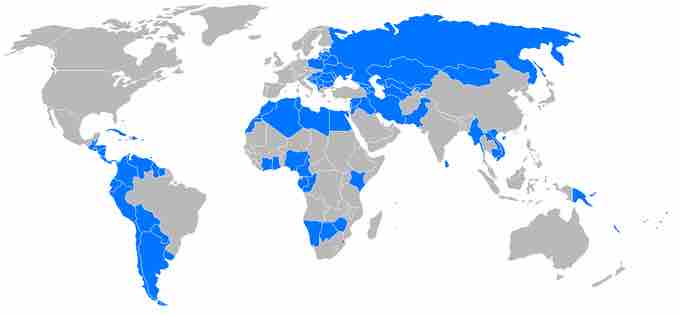An International Standard
Many countries use or are moving towards using the International Financial Reporting Standards (IFRS), which were established and maintained by the International Accounting Standards Board (IASB). In some countries, local accounting principles are applied for regular companies, but listed or larger companies must conform to the IFRS, so statutory reporting is comparable internationally, across jurisdictions .

IFRS in Developing Countries
A map of developing countries, without the least advanced countries and the failed countries.
The IFRS: History and Purpose
The IFRS is designed as a common global language for business affairs so that company accounts are understandable and comparable across international boundaries. They are a consequence of growing international shareholding and trade. The IFRS is particularly important for companies that have dealings in several countries. They are progressively replacing the many different national accounting standards.
The IFRS began as an attempt to harmonize accounting across the European Union, but the value of harmonization quickly made the concept attractive around the world. They are occasionally called by the original name of International Accounting Standards (IAS). The IAS were issued between 1973 and 2001 by the Board of the International Accounting Standards Committee (IASC). On April 1, 2001, the new IASB took over the responsibility for setting International Accounting Standards from the IASC. During its first meeting the new Board adopted existing IAS and Standing Interpretations Committee standards (SICs). The IASB has continued to develop standards calling the new standards the IFRS.
Framework
The Conceptual Framework for Financial Reporting states the basic principles for IFRS. The IASB and FASB frameworks are in the process of being updated and converged. The Joint Conceptual Framework project intends to update and refine the existing concepts to reflect the changes in markets and business practices. The project also intends consider the changes in the economic environment that have occurred in the two or more decades since the concepts were first developed.
Deloitte states:
In the absence of a Standard or an Interpretation that specifically applies to a transaction, management must use its judgment in developing and applying an accounting policy that results in information that is relevant and reliable . In making that judgment, IAS 8.11 requires management to consider the definitions, recognition criteria, and measurement concepts for assets , liabilities , income , and expenses in the Framework. This elevation of the importance of the Framework was added in the 2003 revisions to IAS 8.
IFRS Defined Objective of Financial Statements
A financial statement should reflect true and fair view of the business affairs of the organization. As these statements are used by various constituents of the society/regulators, they need to reflect an accurate view of the financial position of the organization. It is very helpful to check the financial position of the business for a specific period.
Three Basic Accounting Models
- Current Cost Accounting, under Physical Capital Maintenance at all levels of inflation and deflation under the Historical Cost paradigm as well as the Capital Maintenance in Units of Constant Purchasing Power paradigm
- Financial capital maintenance in nominal monetary units, i.e., globally implemented Historical cost accounting during low inflation and deflation only under the traditional Historical Cost paradigm
- Financial capital maintenance in units of constant purchasing power, i.e., Constant Item Purchasing Power Accounting – CIPPA – in terms of a Daily Consumer Price Index or daily rate at all levels of inflation and deflation under the Capital Maintenance in Units of Constant Purchasing Power paradigm and Constant Purchasing Power Accounting – CPPA – during hyperinflation under the Historical Cost paradigm.
Three Underlying Assumptions
- Going concern: for the foreseeable future an entity will continue under the Historical Cost paradigm as well as under the Capital Maintenance in Units of Constant Purchasing Power paradigm
- Stable measuring unit assumption: financial capital maintenance in nominal monetary units or traditional Historical cost accounting only under the traditional Historical Cost paradigm.
- Units of constant purchasing power: capital maintenance in units of constant purchasing power at all levels of inflation and deflation in terms of a Daily Consumer Price Index or daily rate only under the Capital Maintenance in Units of Constant Purchasing Power paradigm.